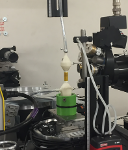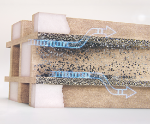____________________________________
Industrial Liaison Group:
Tel: +44 (0) 1235 778797
E-mail: industry@diamond.ac.uk
 To keep ahead of the competition, the automotive industry needs to identify and realise innovative research developments in chemistry, materials science and engineering, to ensure high performance whilst minimising the impact on the environment.
To keep ahead of the competition, the automotive industry needs to identify and realise innovative research developments in chemistry, materials science and engineering, to ensure high performance whilst minimising the impact on the environment.
Diamond provides specialist synchrotron analytical techniques for the atomic to microscale characterisation of materials ranging from catalytic materials and novel advanced components through to coatings and motor oils.
Below are some examples of how these techniques have been applied.

Organic Friction Modifiers (OFMs) are surfactants included in engine oil formulations. They adsorb on metal surfaces, forming compact surface layers that act as protective coatings to reduce friction and wear occurring between mechanical engine parts.
The use of OFMs is associated with more energy-efficient engines and a reduction in CO2 emissions. The design of effective new formulations and novel OFMs relies on a detailed understanding of how OFMs self-assemble at interfaces and how their surface structure changes with tribological conditions.
Read more...
Particulate matter (PM) pollution remains a major public health concern. The installation of particulate filters on the exhaust of road vehicles with combustion engines has been critical in capturing PM before they pollute the environment.
However, the deposits cause the permeability of the filter to change continuously, and over time, without remediation, it can lead to excessive back-pressure from the exhaust, lowering the fuel efficiency of the engine and increasing greenhouse emissions.
Read more...
The control of crystallisation is a perennial problem in many aspects of life – for example: the manufacturing of foodstuffs, polymer products, pharmaceuticals and the operation of transportation fuels. There has always been a wish to be able to change the nucleation and growth of crystallising species simply and efficiently. This would enable the control of wax crystals from diesel fuel, speed up polymer processing, and make pharmaceuticals and dairy products more efficiently.
Read more...
Poor air quality and reduced greenhouse gas emissions are at the forefront of public discussion, as well as being high on the agenda of worldwide policy makers. Many industries are embracing rapid changes in response, as is especially visible in the automotive sector, with the introduction of technologies such as gasoline particulate filters (GPFs). GPFs are positioned in a vehicle’s exhaust system and filter fine particulate matter (PM) produced by the engine. Recent legislation in places such as China, India and Europe will drive the adoption of GPFs on the majority of new gasoline, and hybrid electric, vehicles.
Whilst GPFs benefit public health and the environment by filtering out PM, they can also become gradually blocked by collected material. Captured carbonaceous particles (e.g. soot) can routinely oxidize away; however, inorganic PM (e.g. ash) typically remains in the filter for life, slowly blocking it and potentially reducing the fuel economy and power of the vehicle. Inorganic PM is predominantly derived from engine oil additive chemistry, which plays an important role in improving fuel economy, performance, and engine lifetime.
Read more....jpg)
In the chemical industry and industrial research, catalysis plays a vital role. Catalysts are in constant development to fulfil economic, political and environmental demands. Gaining valuable new information about the atomicnanoscale chemical structure, coupled with information about the micro-distribution of such species, has applications across a wide range of disciplines such as materials, biomedical, environmental, and geophysical sciences.
Read more....jpg)
In today’s battle against climate change, replacement of conventional cars with battery electric vehicles (BEV) offers an opportunity to significantly reduce future carbon dioxide emissions. Currently, BEVs employ lithium-ion batteries which are expensive to produce and have significant drawbacks; their safety and limited transport being the main issues. Significant interest is therefore being shown in replacing these lithium-ion batteries with a lithium-sulfur battery (LiS or Li2S/Si), which operates using a cheap and abundant raw material with about a two-fold higher specific energy compared to lithium-ion batteries.
Read more...
Fuel combustion in diesel engines leads to the production of nitrogen oxides (NOx) which are harmful to the environment. Retarding the fuel injection timing and recirculating the exhaust gas back into the engine reduces overall NOx emissions, however, this can also lead to the formation of diesel soot particles within the engine oil. Excessive build up of soot in engine oil accelerates engine wear, ultimately leading to lower fuel efficiency and premature engine failure.
Read more...
The automotive industry typically uses steel sheets for the bodywork of cars which is cut to the size of the part (i.e. roof, door or bonnet) and then stamped into the precise shape required. Although steel is a commonly-used material, the exact behaviour of the metal’s crystalline structure during these forming processes has yet to be fully mapped. By understanding how the ‘steel crystals’ react when undergoing stamping, new alloys could be created that offer greater flexibility and strength which might allow more complex shapes to be formed.
Read more...
Effective lubrication has a significant impact on a number of applications ranging from human artificial joint implants to energy efficiency of internal combustion engines and the reliability of offshore wind turbine gearboxes. At low running speeds and high contact pressures the fluid film cannot be maintained and therefore effective lubrication is greatly influenced by the presence of chemical additives in the lubricant. These additives interact with the lubricated surfaces to form nanoscale tribofilms that reduce both material wear and energy losses due to friction. Understanding the mechanisms by which these tribofilms form is essential for development and optimisation of the next generation environmentally friendly effective lubricants, materials and tribological systems.
Read more...
Platinum group metals play a crucial role in a variety of applications and in particular for a host of catalytic applications. The largest application is currently in vehicle emission control (VEC) catalysts to efficiently reduce particulate matter, CO, NOx and hydrocarbons. This type of catalytic system is diverse and complex and generally contains 0.1-1 wt% active metal deposited on a thermally stable structural support. Therefore, applying a wide range of techniques is essential to fully understand these complex catalytic materials.
Read more...
The “freezing” of diesel fuel in winter has been a problem since its inception. Wax crystals nucleate and grow and block fuel lines and filters which can lead to vehicle failures and motorists being stranded. Additives are used to control these crystals but, over recent years, the use of biofuels (fatty acid methyl esters) within diesel blends has become increasingly common. This can adversely affect the low temperature operability of the fuel. Legislation demands that biofuels are part of diesel blends throughout the EU, with levels expected to increase.
Read more...Diamond Light Source is the UK's national synchrotron science facility, located at the Harwell Science and Innovation Campus in Oxfordshire.
Copyright © 2022 Diamond Light Source
Diamond Light Source Ltd
Diamond House
Harwell Science & Innovation Campus
Didcot
Oxfordshire
OX11 0DE
Diamond Light Source® and the Diamond logo are registered trademarks of Diamond Light Source Ltd
Registered in England and Wales at Diamond House, Harwell Science and Innovation Campus, Didcot, Oxfordshire, OX11 0DE, United Kingdom. Company number: 4375679. VAT number: 287 461 957. Economic Operators Registration and Identification (EORI) number: GB287461957003.